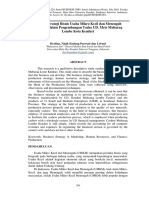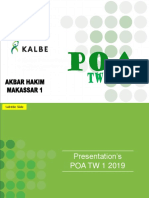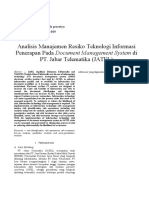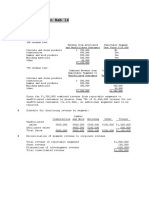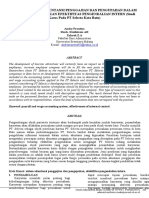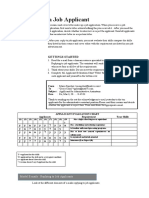JIAN Template1 1
JIAN Template1 1
Uploaded by
Riski SamdaniCopyright:
Available Formats
JIAN Template1 1
JIAN Template1 1
Uploaded by
Riski SamdaniOriginal Description:
Original Title
Copyright
Available Formats
Share this document
Did you find this document useful?
Is this content inappropriate?
Copyright:
Available Formats
JIAN Template1 1
JIAN Template1 1
Uploaded by
Riski SamdaniCopyright:
Available Formats
JIAN: Jurnal Ilmiah Akuntansi dan Keuangan Initial manuscript submission
The title of article should be concise, informative in
sentence case fewer than 16 words
First Author1*, Second author2, and Third author3
1
Department of Accounting, Faculty of Economics and Business, University
2
Department of Accounting, Faculty of Economics and Business, University
3
Department of Accounting, Faculty of Economics and Business, University
ABSTRACT
Introduction/Main Objectives: Describe the topic your paper examines. Provide a background to
your paper and why is this topic interesting. Avoid unnecessary content. Background Problems:
State the problem or economic/business phenomena studied in this paper and specify the research
question(s) in one sentence. Novelty: Summarize the novelty of this paper. Briefly explain why no
one else has adequately researched the question yet. Research Methods: Provide an outline of the
research method(s) and data used in this paper. Explain how did you go about doing this research.
Again, avoid unnecessary content and do not make any speculation(s). Finding/Results: List the
empirical finding(s) and write a discussion in one or two sentences. Conclusion: Provide
conclusion(s) and implication(s) of your research. What conclusions did you get and what are the
implication(s)? What is the main take-home message?
Keywords:
keyword_1, keyword_2, keyword_3, keyword_4, keyword_5
___________
* Corresponding Author at Department of Accounting, Faculty of Economics and Business, Universitas Negeri Makassar,
Jl. Raya Pendidikan No. 1 Gunung Sari, Makassar 90221 South Sulawesi, Indonesia. E-mail address: author@email.com
(author#1), author2@email.com (author#2), author3@email.com (author#3)
Initial manuscript submitted to JIAN: Jurnal Ilmiah Akuntansi dan Keuangan
JIAN: Jurnal Ilmiah Akuntansi dan Keuangan 2
1. Introduction
What is the purpose of the study? Why are you conducting the study? The main section of the article
should start with an introductory section, which provides more details about the paper’s purpose,
motivation, research methods and findings. The introduction should be relatively nontechnical, yet
clear enough for an informed reader to understand the manuscript’s contribution.
The “introduction” in the manuscript is important to demonstrate the motives of the research. It
analyzes the empirical, theoretical and methodological issues in order to contribute to the extant
literature. This introduction will be linked with the following parts, most noticeably the literature
review.
Explaining the problem’s formulation should cover the following points: (1) Problem recognition and
its significance; (2) clear identification of the problem and the appropriate research questions; (3)
coverage of problem’s complexity; and (4) well-defined objectives.
1.2. Heading and subheading
Do not indent the first paragraph of every section or sub section. The Introduction is not an extended
version of the abstract; never use the same sentences in both sections. Please use no more than three
levels of headings.
2. Literature Review
Thus, the second part, “Literature Review” investigates the gap that will be exposed and solved. The
flow of all the ideas are required to be clear, linked, well-crafted and well developed. It serves as the
source of the research question and especially the base or the hypotheses that respond to the research
objective. We advise using current and primary sources from trusted international references (top tier-
journals).
3. Method, Data, and Analysis
The third part of the manuscript, “Method, Data, and Analysis” is designed to describe the nature of
the data. The method should be well elaborated and enhance the model, the approach to the analysis
and the step taken. Equations should be numbered as we illustrate.
This section typically has the following sub-sections: Sampling (a description of the target population,
the research context, and units of analysis; the sample; and respondents’ profiles); data collection; and
measures (or alternatively, measurements).
The research methodology should cover the following points: Concise explanation of the research’s
methodology is prevalent; reasons for choosing the particular methods are well described; the
research’s design is accurate; the sample’s design is appropriate; the data collection processes are
properly conducted; the data analysis methods are relevant and state-of-the-art
4. Result and Discussion
Initial manuscript submitted to JIAN: Jurnal Ilmiah Akuntansi dan Keuangan
JIAN: Jurnal Ilmiah Akuntansi dan Keuangan 3
The author needs to report the results in sufficient detail so that the reader can see which statistical
analysis was conducted and why, and later to justify their conclusions.
The “Discussion and Analysis” part, highlights the rationale behind the result answering the question
“why the result is so?” It shows the theories and the evidence from the results. The part does not just
explain the figures but also deals with this deep analysis to cope with the gap that it is trying to solve.
4.1. Table and Figure
Authors must provide high quality artwork for all illustrations. Poor resolution or definition is not
acceptable. All tables and figures (graphs) should be included directly in the appropriate part of the
article (not separated). Each table or figure should be numerically numbered separately (Table 1, Table
2; Figure 1, Figure 2) and fully titled, which refers to the contents of the table or figure. Underneath
each table and figure, state the reliable source. Use only horizontal lines, 1.5 spaced
Table 1. Title of the table….
Column 1 Column 2 Column 2 Column 2
Abcde1 0.xxx 0.xxx1 0.xxx2
Abcde2 0.yyyy 0.yyyy1 0.yyyy2
Abcde3 0.zzz 0.zzz1 0.zzz2
Abcde4 0.aaaa 0.aaaa1 0.aaaa2
Notes: ….
Source: …..
Initial manuscript submitted to JIAN: Jurnal Ilmiah Akuntansi dan Keuangan
JIAN: Jurnal Ilmiah Akuntansi dan Keuangan 4
Figure 1. Title of the figure……
Source: ……………………..
4.2. Equation
Equations should be numerically numbered consecutively in parentheses with aligning right margin,
and it can use either the same font (Cambria) or the formula font.
Y=α+ßX+ε (1)
5. Conclusion and Suggestion
In this section, the author presents brief conclusions from the results of the research with suggestions
for advanced researchers or general readers. A conclusion may cover the main points of the paper, but
do not replicate the abstract in the conclusion.
Authors should explain the empirical and theoretical benefits, the economic benefits, and the
existence of any new findings. The author may present any major flaws and limitations of the study,
which could reduce the validity of the writing, thus raising questions from the readers (whether, or in
what way), the limits in the study may have affected the results and conclusions. Limitations require a
critical judgment and interpretation of the impact of their research. The author should provide the
answer to the question: Is this a problem caused by an error, or in the method selected, or the validity,
or something else?
Acknowledgement (if any)
Author (s) may acknowledge a person or organization that helped him/her/them in many ways. Please
use the singular heading even if you have many acknowledgments.
Reference
In this section, author (s) must list all the reference documents cited in the text. In writing the
reference, the author(s) are recommended to use reference management tools, such as Mendeley. The
citation and reference list should follow the American Psychological Association (APA) referencing
style (6th edition). Otherwise, please follow the format of the sample references and citations as shown
in this guide.
Authors are encouraged to cite manuscripts mainly from primary source publications (journals) from
the last ten years. In addition, authors should avoid excessively referencing their own work (self-
citation).
A basic format to list the reference documents as follows:
Initial manuscript submitted to JIAN: Jurnal Ilmiah Akuntansi dan Keuangan
JIAN: Jurnal Ilmiah Akuntansi dan Keuangan 5
1. The reference list is arranged in alphabetical order by the authors’ last names
2. If there is more than one work by the same author, order them by publication date, oldest to newest.
3. If there is no author the title moves to that position and the entry is alphabetized by the first
significant word, excluding words such as “A” or “The”. If the title is long, it may be shortened
when citing in text.
4. The first line of the reference list entry is left-hand justified, while all subsequent lines are
consistently indented.
5. Use “&” instead of “and” when listing multiple authors of a source.
6. Capitalize only the first word of the title and of the subtitle, if there is one, plus any proper names –
i. e. only those words that would normally be capitalized.
7. Italicize the title of the book, the title of the journal/serial and the title of the web document.
8. For any non-English articles, please write down the translation of the article in brackets [ ] after the
original article’s title. Note that the original article should be written in italics.
9. Do not create separate lists for each type of information source.
Some example of the reference list
Journal
Karlan, D. S., & Zinman, J. (2012). List randomization for sensitive behavior: An application for
measuring use of loan proceeds. Journal of Development Economics, 98(1), 71-75.
Gabbett, T., Jenkins, D., & Abernethy, B. (2010). Physical collisions and injury during professional
rugby league skills training. Journal of Science and Medicine in Sport, 13(6), 578-583.
doi:10.1016/j.jsams.2010.03.007
Conference Paper/Proceeding
Williams, J., & Seary, K. (2010). Bridging the divide: Scaffolding the learning experiences of the
mature age student. In J. Terrell (Ed.), Making the links: Learning, teaching and high quality
student outcomes. Proceedings of the 9th Conference of the New Zealand Association of Bridging
Educators (pp. 104-116). Wellington, New Zealand.
MacColl, F., Ker, I., Huband, A., Veith, G., & Taylor, J. (2009, November 12-13). Minimising
pedestrian-cyclist conflict on paths. Paper presented at the Seventh New Zealand Cycling
Conference, New Plymouth, New Zealand. Retrieved from
http://cyclingconf.org.nz/system/files/NZCyclingConf09_2A_MacColl_ PedCycleConflicts.pdf
Dissertation
Mann, D. L. (2010). Vision and expertise for interceptive actions in sport (Doctoral dissertation, The
University of New South Wales, Sydney, Australia). Retrieved from
http://handle.unsw.edu.au/1959.4/44704
Books
Collier, A. (2008). The world of tourism and travel. Rosedale, New Zealand: Pearson Education New
Zealand.
Airey, D. (2010). Logo design love: A guide to creating iconic brand identities. Berkeley, CA: New
Riders.
Whitney, E., & Rolfes, S. (2011). Understanding nutrition (12th ed.). Australia: Wadsworth Cengage
Learning.
Initial manuscript submitted to JIAN: Jurnal Ilmiah Akuntansi dan Keuangan
JIAN: Jurnal Ilmiah Akuntansi dan Keuangan 6
Book Chapter
Palmer, F. (2007). Treaty principles and Maori sport: Contemporary issues. In C. Collins & S. Jackson
(Eds.), Sport in Aotearoa/New Zealand society (2nd ed., pp. 307-334). South Melbourne, Australia:
Thomson.
Newspaper
Matthews, L. (2011, November 23). Foodbanks urge public to give generously. Manawatu Standard,
p. 4.
Little blue penguins homeward bound. (2011, November 23). Manawatu Standard, p. 5.
Rogers, C. (2011, November 26). Smartphone could replace wallets. The Dominion Post. Retrieved
from http://www.stuff.co.nz/technology/gadgets/6038621/Smartphone-could-replace-wallets
Act (statute/legistation)
Health and Safety in Employment Act 1992. (2013, December 16). Retrieved from
http://www.legislation.govt.nz
Internet
Ministry of Health. (2014). Ebola: Information for the public. Retrieved from
http://www.health.govt.nz/your-health/conditions-and-treatments/diseases-and-illnesses/ebola-
information-public
Initial manuscript submitted to JIAN: Jurnal Ilmiah Akuntansi dan Keuangan
You might also like
- G1 ManuscriptDocument79 pagesG1 ManuscriptJaypee SaymanNo ratings yet
- Tugas Bahasa Inggris E-CommerceDocument5 pagesTugas Bahasa Inggris E-CommerceGilarGandara100% (1)
- Universitas Pamulang: SK MENDIKNAS NO.136/D/0/2001Document3 pagesUniversitas Pamulang: SK MENDIKNAS NO.136/D/0/2001TytawardaniNo ratings yet
- Universiti Utara Malaysia Othman Yeop Abdullah Graduate School of Business (Oyagsb) A201 2020/2021Document2 pagesUniversiti Utara Malaysia Othman Yeop Abdullah Graduate School of Business (Oyagsb) A201 2020/2021fitriNo ratings yet
- Kelompok 6 - Tugas Week 13 - Akuntansi Manajemen - LDocument3 pagesKelompok 6 - Tugas Week 13 - Akuntansi Manajemen - LMuhammad Rizki NoorNo ratings yet
- Formulating Aims and ObjectivesDocument6 pagesFormulating Aims and ObjectivesHoh JoeyNo ratings yet
- The Commons (Disciplinary and Interdisciplinary Encounters) - Janet Gail DonaldDocument15 pagesThe Commons (Disciplinary and Interdisciplinary Encounters) - Janet Gail DonaldDaniel AlcanzarinNo ratings yet
- E3-5 (LO 3) Adjusting Entries: InstructionsDocument6 pagesE3-5 (LO 3) Adjusting Entries: InstructionsAntonios Fahed0% (1)
- Analisis Manajemen Strategik Pada Apple IncDocument53 pagesAnalisis Manajemen Strategik Pada Apple IncAnastacia TakashiNo ratings yet
- TCID Annual Report 2014Document166 pagesTCID Annual Report 2014Vincent S VincentNo ratings yet
- Bankrupt PT SariwangiDocument5 pagesBankrupt PT Sariwangifasha muthaharNo ratings yet
- Analisis Sistem Informasi Akuntansi Penjualan Pada PT Hadji Kalla (Toyota) Cabang PinrangDocument13 pagesAnalisis Sistem Informasi Akuntansi Penjualan Pada PT Hadji Kalla (Toyota) Cabang Pinrangmuhammad rezaNo ratings yet
- MYOB Qualification Test: Level BasicDocument8 pagesMYOB Qualification Test: Level BasicGalihNo ratings yet
- Analisis Strategi Bisnis Usaha Mikro Kecil Dan Menengah (UMKM) Dalam Pengembangan Usaha UD. Mete Mubaraq Lombe Kota KendariDocument12 pagesAnalisis Strategi Bisnis Usaha Mikro Kecil Dan Menengah (UMKM) Dalam Pengembangan Usaha UD. Mete Mubaraq Lombe Kota KendariPutri 123No ratings yet
- MNO Chapter 06 - Strategic Management - How Exceptional Managers Realise A Grand DesignDocument14 pagesMNO Chapter 06 - Strategic Management - How Exceptional Managers Realise A Grand DesignDouglas FongNo ratings yet
- Template PowerPoint Kalbe 2018 Plus KALBE Is YOUDocument24 pagesTemplate PowerPoint Kalbe 2018 Plus KALBE Is YOURyan MwNo ratings yet
- Contoh Kasus Resiko ItDocument14 pagesContoh Kasus Resiko Itagata ekaNo ratings yet
- Resume SPM CompileDocument53 pagesResume SPM Compilevita zoomNo ratings yet
- Business To Government (B2G)Document9 pagesBusiness To Government (B2G)indra gunawanNo ratings yet
- RudiSetiadi 16AKJ ManagementAuditDocument2 pagesRudiSetiadi 16AKJ ManagementAuditRudi SetiadiNo ratings yet
- Bab 14. Jawaban Contoh SoalDocument2 pagesBab 14. Jawaban Contoh SoalVanaNo ratings yet
- Overview AuditDocument58 pagesOverview AuditRikky Adiwijaya100% (1)
- Makalah Perkembangan Ekonomi Di IndonesiaDocument9 pagesMakalah Perkembangan Ekonomi Di IndonesiaPapua NetNo ratings yet
- Volume Penjualan Dan Biaya Operasional Terhadap Laba Bersih PDFDocument19 pagesVolume Penjualan Dan Biaya Operasional Terhadap Laba Bersih PDFmursidi imungNo ratings yet
- Tugas Bahasa Inggris 3Document3 pagesTugas Bahasa Inggris 3Andri SahlanNo ratings yet
- Advance P13-14Document10 pagesAdvance P13-14nadaNo ratings yet
- Pengaruh Lingkungan Internal Dan Eksternal Terhadap Keunggulan Bersaing Dan Kinerja Usaha Kecil Menengah (UKM) Di MadiunDocument10 pagesPengaruh Lingkungan Internal Dan Eksternal Terhadap Keunggulan Bersaing Dan Kinerja Usaha Kecil Menengah (UKM) Di MadiunSlametRiyantoNo ratings yet
- Teori Sinyal Dalam Manajemen Keuangan: September 2009Document31 pagesTeori Sinyal Dalam Manajemen Keuangan: September 2009Gabriella SumendaNo ratings yet
- BSDE Annual Report 2018Document38 pagesBSDE Annual Report 2018Furqon MuhammadNo ratings yet
- Analisis Program Dan Prosedur Audit Pada PT XL Axiata Tbk. - KELOMPOK 4 - AUDITING IIDocument40 pagesAnalisis Program Dan Prosedur Audit Pada PT XL Axiata Tbk. - KELOMPOK 4 - AUDITING IIRifqi Aqilla DivasyahNo ratings yet
- Modul AKLII-6 - Intercompany Plant AssetDocument30 pagesModul AKLII-6 - Intercompany Plant AssetPutri Shinta IndryaniNo ratings yet
- Letters and Application Letters: ObjectivesDocument10 pagesLetters and Application Letters: ObjectivesEmi Suryani SilalahiNo ratings yet
- Chapter 10 - Ethical Decision MakingDocument38 pagesChapter 10 - Ethical Decision MakingGraceNo ratings yet
- Accounting For Pensions and Postretirement BenefitsDocument3 pagesAccounting For Pensions and Postretirement BenefitsdwitaNo ratings yet
- AALI Annual Report 2017Document220 pagesAALI Annual Report 2017FendiNo ratings yet
- RMK Teori Akuntansi - Konsep Pendapatan - Kelompok 01 - Kelas D8Document11 pagesRMK Teori Akuntansi - Konsep Pendapatan - Kelompok 01 - Kelas D8Septi AriyantiNo ratings yet
- Jawaban Uas B.ingDocument3 pagesJawaban Uas B.ingAndry WigunaNo ratings yet
- PT Selecta Kota BatuDocument11 pagesPT Selecta Kota BatuYanuar Dicky PradanaNo ratings yet
- Materi Kuliah 2 - Financial Reporting and AnalysisDocument90 pagesMateri Kuliah 2 - Financial Reporting and Analysisvia nurainiNo ratings yet
- Pertemuan 3 StakeholdersDocument17 pagesPertemuan 3 StakeholdersRifky Chaidir100% (1)
- Ec Chapter 3Document13 pagesEc Chapter 3Sefa AnjaniNo ratings yet
- AYLS Annual Report 2019 LampDocument136 pagesAYLS Annual Report 2019 LampHigh FourNo ratings yet
- Definisi Dan Sejarah IfrsDocument20 pagesDefinisi Dan Sejarah IfrsGinda Rafiel Sitorus PaneNo ratings yet
- Chapter 10 Credit AnalysisDocument69 pagesChapter 10 Credit AnalysisRobertus GaniNo ratings yet
- Faktor-Faktor Yang Menjelaskan Variasi Relevansi NilaiDocument16 pagesFaktor-Faktor Yang Menjelaskan Variasi Relevansi NilaiMellani PuspitasariNo ratings yet
- PT Qu-Be Berseri Worksheet: December 2019Document5 pagesPT Qu-Be Berseri Worksheet: December 2019Orlando29100% (1)
- Tugas Bab 3 Pemasaran Dan Pengembangan ProdukDocument1 pageTugas Bab 3 Pemasaran Dan Pengembangan ProdukallamNo ratings yet
- Praktikum Audit Modul 1-9 by Taufik Rahman (A031171029) Fix-CompressedDocument136 pagesPraktikum Audit Modul 1-9 by Taufik Rahman (A031171029) Fix-CompressedMiftaNo ratings yet
- Gleaning Information From Financial Statements: ReadingDocument1 pageGleaning Information From Financial Statements: ReadingYanetNo ratings yet
- Pertemuan 6 Analisis Investasi Antar Perusahaan (Intercompany Investment Analysis)Document23 pagesPertemuan 6 Analisis Investasi Antar Perusahaan (Intercompany Investment Analysis)putri pertiwiNo ratings yet
- Cash and Liquidity Denitto Giantoro - 20.0102.0071Document10 pagesCash and Liquidity Denitto Giantoro - 20.0102.0071Denitto Giantoro100% (2)
- The Lockit Company Manufactures Door Knobs For Residential Homes andDocument2 pagesThe Lockit Company Manufactures Door Knobs For Residential Homes andAmit PandeyNo ratings yet
- Usulan Perancangan Sistem Customer Relationship Management (CRM) Outlet Air Minum Isi Ulang Daily Fresh Water Menggunakan Metode CRM-IRISDocument10 pagesUsulan Perancangan Sistem Customer Relationship Management (CRM) Outlet Air Minum Isi Ulang Daily Fresh Water Menggunakan Metode CRM-IRISIrfan PrimantoNo ratings yet
- The Size of Government: Measurement, Methodology and Official StatisticsFrom EverandThe Size of Government: Measurement, Methodology and Official StatisticsNo ratings yet
- Soal ProblemDocument2 pagesSoal ProblemZulan IlmadaNo ratings yet
- Rangkaian Kegiatan Yang Mempengaruhi Sistem InformasiDocument3 pagesRangkaian Kegiatan Yang Mempengaruhi Sistem InformasiwulaneeyyNo ratings yet
- Chapter 11-Part 1 Share Transaction Soal 1Document2 pagesChapter 11-Part 1 Share Transaction Soal 1Nicko Arisandiy0% (1)
- Annual Report Laporan Tahunan: PT Gudang Garam TBKDocument132 pagesAnnual Report Laporan Tahunan: PT Gudang Garam TBKAnnisa Rosie NirmalaNo ratings yet
- SHR ToolsDocument11 pagesSHR ToolssayaliNo ratings yet
- Evaluasi Salah Saji Yang Teridentifikasi Selama AuditDocument23 pagesEvaluasi Salah Saji Yang Teridentifikasi Selama AuditNico Hadi GelianNo ratings yet
- Chapter 10 Resolving Business Ethical ChallengesDocument2 pagesChapter 10 Resolving Business Ethical ChallengesOgnjenNo ratings yet
- Penerapan PSAK 73 - MaterialDocument77 pagesPenerapan PSAK 73 - Materialni made safitriNo ratings yet
- (EN) MODEL - Collaboration Protocol - O-PitblastDocument3 pages(EN) MODEL - Collaboration Protocol - O-PitblastBassirouNo ratings yet
- EAPP PRESENTATIONGroup4&9Document25 pagesEAPP PRESENTATIONGroup4&9Jayy H. Lopez33% (3)
- Principles of MarketingDocument20 pagesPrinciples of MarketingAngel BorjaNo ratings yet
- A-2 Design PracticalsDocument13 pagesA-2 Design PracticalsxutemNo ratings yet
- Aguilar Le Week 6 LGSDocument5 pagesAguilar Le Week 6 LGSShiela MaeNo ratings yet
- Quezon City Polytechnic University: Research MethodologyDocument14 pagesQuezon City Polytechnic University: Research MethodologyKavin Dela CruzNo ratings yet
- El Met. James Spradley (Ingles-Publicado)Document6 pagesEl Met. James Spradley (Ingles-Publicado)Norman Garrido CabezasNo ratings yet
- CLC Capstone ProposalDocument4 pagesCLC Capstone Proposalapi-330069700No ratings yet
- Final Capsule 2 1Document10 pagesFinal Capsule 2 1Ange SandaNo ratings yet
- Master Bio Medical Engineering Guide Aug 09Document41 pagesMaster Bio Medical Engineering Guide Aug 09amirophobiaNo ratings yet
- 10 1108 - Ijoa 04 2021 2719Document18 pages10 1108 - Ijoa 04 2021 2719Malinda AmeliaNo ratings yet
- Inventory Management Techniques of Heat Stores in Metro Manila, Basis For Improvement of Inventory Management SystemDocument10 pagesInventory Management Techniques of Heat Stores in Metro Manila, Basis For Improvement of Inventory Management SystemioerimrjNo ratings yet
- Qualitative Research: Dosen Pengampu: Ayu Rizki Septiana .M.PDDocument12 pagesQualitative Research: Dosen Pengampu: Ayu Rizki Septiana .M.PDEndouYukioNo ratings yet
- FT Academic Calendar Final Eng PDFDocument3 pagesFT Academic Calendar Final Eng PDFHo Yi TangNo ratings yet
- It Modernize Data Architecture Phase 1 Develop A DA VisionDocument25 pagesIt Modernize Data Architecture Phase 1 Develop A DA VisionMARIA SELES TELES SOUSA100% (1)
- Research ProposalDocument4 pagesResearch Proposalxyz8910100% (2)
- Strengths and Limitations of Qualitative and Quantitative Research MethodsDocument20 pagesStrengths and Limitations of Qualitative and Quantitative Research MethodsWanda JiménezNo ratings yet
- Ched Form E5 - Faculty or Teaching Staff in Higher Education ProgramsDocument13 pagesChed Form E5 - Faculty or Teaching Staff in Higher Education ProgramsRobelyn Fababier VeranoNo ratings yet
- Fymca PCP Centre 2014-15 2Document30 pagesFymca PCP Centre 2014-15 2Virendra ArekarNo ratings yet
- Research Assumption and HypothesisDocument13 pagesResearch Assumption and HypothesisKhusni RiyaNo ratings yet
- My Research ProposalDocument6 pagesMy Research ProposalSarfo Mensah100% (2)
- Implementing Culture Change in Health Care: Theory and PracticeDocument15 pagesImplementing Culture Change in Health Care: Theory and PracticeElvisa FitriNo ratings yet
- Abbott 2004Document19 pagesAbbott 2004Sahirr SahirNo ratings yet
- M.tech Civil SyllabusDocument101 pagesM.tech Civil SyllabusSamkit ChhajedNo ratings yet
- White - 2021 - Self-Determination Theory in Physical Education - A Systematic Review of Qualitative StudiesDocument13 pagesWhite - 2021 - Self-Determination Theory in Physical Education - A Systematic Review of Qualitative Studiesgabrielpcarvalho20016No ratings yet
- Course Coordinator & Lecturer Qihui Jiang (Vivi Kasim), PHD: Academic BackgroundsDocument11 pagesCourse Coordinator & Lecturer Qihui Jiang (Vivi Kasim), PHD: Academic BackgroundsRefsya Azanti PutriNo ratings yet
- Factors Associated With Public School Chronic AbsenteeismDocument167 pagesFactors Associated With Public School Chronic AbsenteeismKristine EdquibaNo ratings yet













